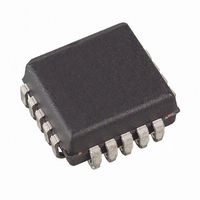ATF16V8C-7JU Atmel, ATF16V8C-7JU Datasheet - Page 8

ATF16V8C-7JU
Manufacturer Part Number
ATF16V8C-7JU
Description
IC PLD 7NS 20PLCC
Manufacturer
Atmel
Specifications of ATF16V8C-7JU
Programmable Type
EE PLD
Number Of Macrocells
8
Voltage - Input
5V
Speed
7ns
Mounting Type
Surface Mount
Package / Case
20-PLCC
Family Name
ATF16V8C
Process Technology
EECMOS
# Macrocells
8
# I/os (max)
8
Frequency (max)
125MHz
Propagation Delay Time
7.5ns
Operating Supply Voltage (typ)
5V
Operating Supply Voltage (min)
4.5V
Operating Supply Voltage (max)
5.5V
Operating Temp Range
-40C to 85C
Operating Temperature Classification
Industrial
Mounting
Surface Mount
Pin Count
20
Logic Family
ATF16V8C
Maximum Operating Frequency
125 MHz
Number Of Programmable I/os
8
Delay Time
7.5 ns
Operating Supply Voltage
5 V
Maximum Operating Temperature
+ 85 C
Minimum Operating Temperature
- 40 C
Mounting Style
SMD/SMT
Number Of Product Terms Per Macro
8
Supply Voltage (max)
5.5 V
Supply Voltage (min)
4.5 V
Lead Free Status / RoHS Status
Lead free / RoHS Compliant
Available stocks
Company
Part Number
Manufacturer
Quantity
Price
Company:
Part Number:
ATF16V8C-7JU
Manufacturer:
ATM
Quantity:
3 000
Company:
Part Number:
ATF16V8C-7JU
Manufacturer:
ATM
Quantity:
3 000
Company:
Part Number:
ATF16V8C-7JU
Manufacturer:
ATMEL
Quantity:
120
Part Number:
ATF16V8C-7JU
Manufacturer:
ATMEL/爱特梅尔
Quantity:
20 000
15.
16.
8
Functional logic diagram description
The logic option and functional diagrams describe the ATF16V8C architecture. Eight configurable macrocells can be
configured as a registered output, combinatorial I/O, combinatorial output, or dedicated input.
The ATF16V8C can be configured in one of three different modes. Each mode makes the ATF16V8C look like a different
device. Most PLD compilers can choose the right mode automatically. The user can also force the selection by supplying
the compiler with a mode selection. The determining factors would be the usage of register versus combinatorial outputs
and dedicated outputs versus outputs with output enable control.
The ATF16V8C universal architecture can be programmed to emulate many 20-pin PAL devices. These architectural
subsets can be found in each of the configuration modes described in the following pages. The user can download the
listed subset device JEDEC programming file to the PLD programmer, and the ATF16V8C can be configured to act like the
chosen device. Check with your programmer manufacturer for this capability.
Unused product terms are automatically disabled by the compiler to decrease power consumption. A security fuse, when
programmed, protects the content of the ATF16V8C. Eight bytes (64 fuses) of user signature are accessible to the user
for purposes such as storing project name, part number, revision, or date. The user signature is accessible regardless of the
state of the security fuse.
Table 15-1.
Note:
Macrocell configuration
Software compilers support the three different OMC modes as different device types. These device types are listed in the
table below. Most compilers have the ability to automatically select the device type, generally based on the register usage
and output enable (OE) usage. Register usage on the device forces the software to choose the registered mode. All
combinatorial outputs with OE controlled by the product term will force the software to choose the complex mode. The
software will choose the simple mode only when all outputs are dedicated combinatorial without OE control. The different
device types listed in the table can be used to override the automatic device selection by the software. For further details,
refer to the compiler software manuals.
When using compiler software to configure the device, the user must pay special attention to the following restrictions in
each mode.
In registered mode, pin 1 and pin 11 are permanently configured as clock and output enable, respectively. These pins
cannot be configured as dedicated inputs in the registered mode.
In complex mode, pin 1 and pin 11 become dedicated inputs and use the feedback paths of pin 19 and pin 12
respectively. Because of this feedback path usage, pin 19 and pin 12 do not have the feedback option in this mode.
ABEL, Atmel-ABEL
CUPL, Atmel-CUPL
LOG/iC
OrCAD-PLD
PLDesigner
Synario/Atmel-Synario
Tango-PLD
Atmel ATF16V8C
With PD ENABLE
With PD ENABLE
With PD ENABLE
1. Please call Atmel PLD Hotline at (408) 436-4333 for more information
2. Only applicable for version 3.4 or lower
Compiler mode selection
P16V8R
P16V8PDR
G16V8MS
G16V8CPMS
GAL16V8_R
“Registered”
P16V8R
NA
NA
G16V8R
Registered
(1)
(2)
P16V8C
G16V8CPMA
P16V8C
NA
NA
G16V8C
P16V8PDC
G16V8MA
GAL16V8_C7
“Complex”
Complex
(1)
(2)
P16V8AS
P16V8PD
G16V8CPAS
GAL16V8_C8
P16V8C
NA
NA
G16V8AS
G16V8AS
“Simple”
Simple
(1)
(2)
P16V8
P16V8PDS
G16V8A
G16V8CP
GAL16V8
GAL16V8A
P16V8A
ATF16V8C ALL
ATF16V8C (PD) ALL
G16V8
Auto select
(1)
0425H–PLD–3/11
(1)


















